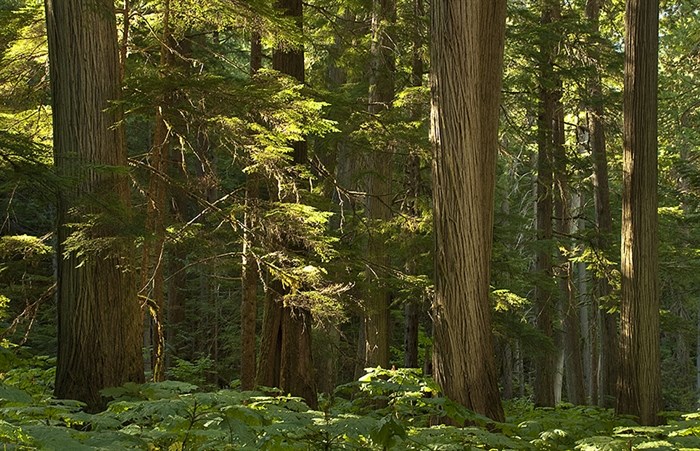
Giant western red cedars in the inland temperate rainforest populate river valleys from the U.S. border north to Wells Gray Provincial Park.
Image Credit: SUBMITTED/Valhalla Wilderness Society/Anne Sherrod
July 04, 2022 - 8:03 AM
B.C. is home to a sprawling old-growth rainforest, but it's not where you might think.
Interior residents and tourists may be familiar with the Giant Cedars Boardwalk near the Trans Canada Highway, but those trees are part of a larger stand of rainforest that traps moisture in the valleys between some of B.C.'s largest interior mountain ranges.
From the Prince George area to the U.S. border, a loosely connected inland temperate rainforest populates river valleys with western red cedars and hemlocks that can be more than a thousand years old. The wet environment and shielded forest floors are also populated with hundreds of species of lichen and mushrooms, many of which are commonly only found in the province's coastal rainforests.
Craig Pettitt of the Valhalla Wilderness Society has been trying to protect the forests from logging and industry for years, with the group even proposing a swath of park land in order to give roaming caribou a stable and permanent habitat.
Pettitt and Valahalla have been particularly interested in the old-growth areas in the Selkirk mountains where Pettitt has estimated some trees to be nearly 2,000 years old. One tree at the northern tip of the Duncan Reservoir is measured on the "B.C. Big Tree" registry. In 2021, the western red cedar was measured at 48 metres tall and nearly 3 metres in diameter.
But his age estimates have been met with disagreement from local loggers.
"I've been in many arguments with foresters that insist the trees can't be that old and I ask them for evidence," he said. "I show them mine."
READ MORE: B.C. defers logging across an additional 1.7 million hectares of old-growth forests
Although the often hollowed and ancient trees are not typically sought after by area loggers, Pettitt says logging nearby puts the rainforests at risk.
The inland rainforest is one of only a few in the world with the other two found in Russia. One is in central Siberia while the other is in the far east reaches of the country.
Despite its rarity, only parts of the inland rainforest are protected under old growth deferrals, like the Incomappleux Valley. Those orders from the province, however, are only temporary.
The environmentalist group pitched a nearly 156,500 hectare provincial park proposal to the government in an attempt to protect the trees and the unique ecosystem the valleys harbour, but it's been met with little progress.

The old-growth rainforest forest features trees estimated to be almost 2,000 years old.
Image Credit: SUBMITTED/Valhalla Wilderness Society/Craig Pettitt
The Selkirk Caribou Mountain Park, officially proposed to the province in 2011, would connect other established parks like Bugaboo Provincial Park, Goat Range Provincial Park and Glacier National Park. Valhalla proposed the park not only to protect the forest itself, but to protect mountain caribou, which feed on the abundant lichen on old-growth trees.
READ MORE: Understanding B.C.'s old-growth logging deferrals by the numbers
Hundreds of different lichens are found throughout the forests which would typically only be found along B.C.'s coast.
Pettitt said a mountain caribou herd that roamed the area is down to less than 30 animals now, but 30 years ago, that herd had more than 200.
Keeping the forest protected would also protect the animals that roam that area, he said.
"Overall, old-growth cedar and hemlock trees in the interior are very much at risk," Pettitt said.
Pettitt is particularly concerned about a piece of the rainforest near the Duncan Lake reservoir, south of Glacier National Park. Logging in the valley bottom has Pettitt concerned for the area's future once the old-growth deferral expires.
"We're concerned opening a parallel cut block can open up the area for wind and dry out... the forest," he said. "In (the park proposal), we suggest the whole area should be left to recover."
READ MORE: Logging company’s deferrals of old-growth jewels bittersweet, environmentalists say
The federal government recognizes the rainforest as extending from the U.S. border north to Wells Gray Provincial Park, with old-growth hemlocks and red cedars rising where mountain ranges like the Selkirks and Purcells trap rain systems in river valleys.
Along with big trees and lichen, mushrooms often strictly found in coastal forests and some found nowhere else on earth populate the rainforest, according to the park proposal.
The federal government acknowledges that two national parks, Glacier and Mount Revelstoke, aren't enough.
"(These parks) cannot preserve sufficient old-growth forests to maintain biodiversity, including old growth dependent species such as mountain caribou," a federal government webpage dedicated to the inland rainforest reads.
Valhalla sent a written petition to the provincial government and runs another one online calling for the protection of the old-growth forests in the Selkirks.
Pettitt said not much has changed, but he remains hopeful and is supportive of protesters at Fairy Creek who continue to oppose logging in remote the Vancouver Island old-growth forest.
"We really respect what the people are doing in Fairy Creek," Pettitt said. "In this time of climate change and the importance of old-growth forests, it isn't reconcilable that people protecting these old-growth forests are being treated like criminals."
To contact a reporter for this story, email Levi Landry or call 250-819-3723 or email the editor. You can also submit photos, videos or news tips to the newsroom and be entered to win a monthly prize draw.
We welcome your comments and opinions on our stories but play nice. We won't censor or delete comments unless they contain off-topic statements or links, unnecessary vulgarity, false facts, spam or obviously fake profiles. If you have any concerns about what you see in comments, email the editor in the link above.
News from © iNFOnews, 2022